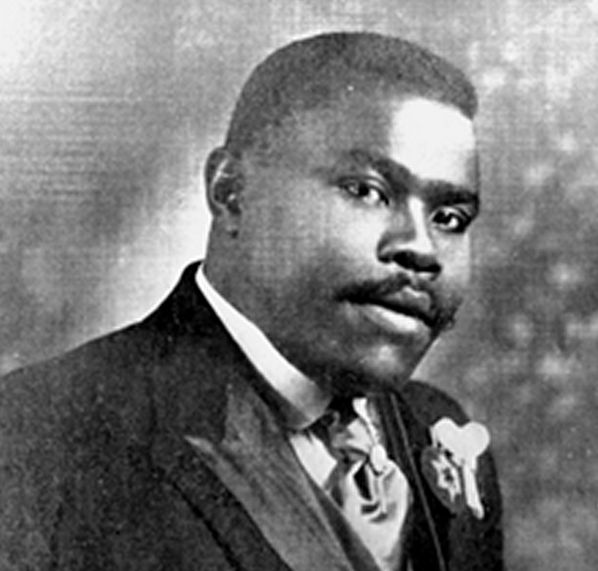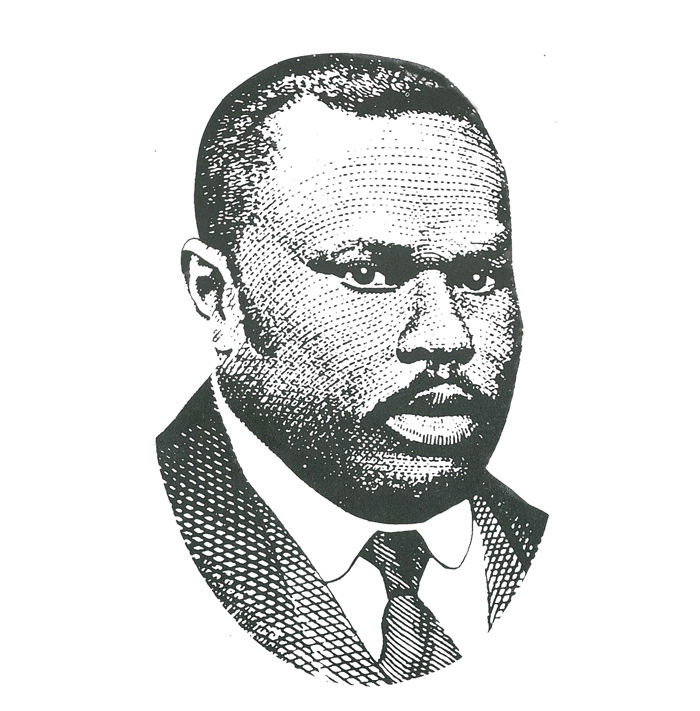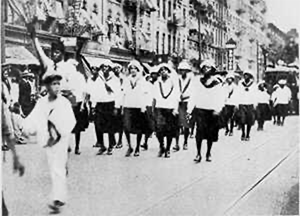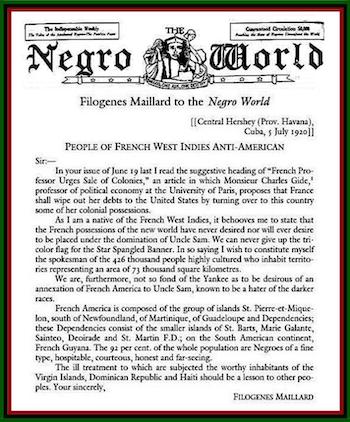
The Negro Factories Corporation
"Negro producers, Negro distributors, Negro consumers!
The world of Negroes can be self-contained.
We desire earnestly to deal with the rest of the world,
but if the rest of the world desire not, we seek not."
Marcus Garvey, 1929
The Negro Factories Corporation was the finance arm of the Universal Negro Improvement Association.
A cornerstone of Garvey's vision for black economic independence, the Negro Factories Corporation was created to support businesses that would employ African Americans and produce goods to be sold to black consumers.
Garvey envisioned a string of black-owned factories, retailers, services, and other businesses and hoped the corporation would eventually be strong enough to power and sustain an all-black economy with worldwide significance.
The Negro Factories Corporation was incorporated in the state of Delaware on January 30, 1920, by Garvey, William Ferris, and John G. Bayne.
Amy Jacques Garvey was secretary of the corporation, and Cyril Henry was its treasurer.
In May 1920, just months after its founding, Garvey reported that the corporation had taken over the management of a Harlem steam laundry and would soon open a millinery and hat factory.
By June 1920, the Negro Factories Corporation had opened the Universal Steam Laundry, with a Universal Tailoring and Dress Making department, at 62 West 142nd Street in Harlem.
At this location, U.N.I.A. uniforms and insignia were manufactured, and fashionable clothing was designed for U.N.I.A. fashion shows at Liberty Hall, the U.N.I.A.'s international headquarters.
The Negro Factories Corporation also supported three grocery stores in Harlem, one on 135th Street and two on Lenox Avenue; two restaurants, one on 135th Street and the other at Liberty Hall; and a printing press.
Local U.N.I.A. branches were urged by Garvey to own their buildings, and they sometimes launched businesses as well.
For example, the Colon, Panama branch of the U.N.I.A. ran a cooperative bakery. In contrast, the Kingston, Jamaica branch ran a laundry and a cooperative bank, the shares of which were available to U.N.I.A. members only.
Garvey's vision for economic self-reliance extended beyond the Negro Factories Corporation. U.N.I.A. branches often acted as mutual aid societies, providing death benefits, small loans, and employment assistance to members.
The Negro Factories Corporation never achieved the scope or influence Garvey envisioned. Still, U.N.I.A. businesses provided an important beacon of hope for African Americans, who were shut out of large segments of the job market and the economy. At their height, U.N.I.A. businesses employed hundreds of people in Harlem.
Ultimately, the Negro Factories Corporation fell victim to organizational mismanagement and unrealistic hopes.
It became insolvent in 1921.

Courtesy: The Marcus Garvey and UNIA Papers Project
As Marcus Garvey returned to Jamaica in 1914, after four years in Central America and Europe, he came upon the autobiography of Booker T. Washington, the conservative dean of American black leaders. It was while reading Up from Slavery, Garvey said, that he developed his vision for the Universal Negro Improvement Association.
"Where is the black man's government?"
Garvey asked himself. "Where is his King and his kingdom?
Where is his President, his ambassador, his country, his men of big affairs? I could not find them," he said, "and then I declared, 'I will help to make them.'"
On July 20, 1914, Marcus Garvey, at the age of twenty-eight, founded the Universal Negro Improvement Association.
His co-founder was Amy Ashwood, who would later become his first wife.
The U.N.I.A. was originally conceived as a benevolent or fraternal reform association dedicated to racial uplift and establishing educational and industrial opportunities for blacks, taking Booker T. Washington's Tuskegee Institute as a model.
The U.N.I.A. floundered in Jamaica. But shortly after Garvey's relocation to Harlem in 1916, New York became the movement's headquarters. The Harlem branch started with 17 members meeting in a dingy basement.
By the spring of 1918, Garvey's strong advocacy of black economic and political independence had taken hold, and U.N.I.A. branches and divisions were springing up in cities and towns across the country and then in different parts of the world.
By 1920 Garvey claimed nearly a thousand local divisions in the United States, the Caribbean, Central America, Canada, and Africa.
Garvey's followers were largely ordinary people, described by the Baltimore Observer as "cooks, porters, hod carriers, and washwomen," and said Garvey should have on the official seal of the empire "a washtub, a frying pan, a bailhook, and a mop."
Large branch meetings were like religious revivals, with entire families gathering for a day of debates, fashion shows, classical music, plays, and vaudeville acts.
Garvey gave his followers, who were dispossessed in the broader society, a sense of belonging. Men could join the African Legion.
For young people, the U.N.I.A. Juvenile Division. And in the Black Cross Nurses and the Universal Motor Corps, the Garvey movement offered black women a place of their own.
He created the red, black, and green flag to symbolize black unity. And there were official U.N.I.A. slogans, prayers, poetry, and songs.
Garvey was known to rule the U.N.I.A. with an iron hand.
He did not tolerate disagreement on insignificant matters and demanded complete loyalty from U.N.I.A. members.
His autocratic style would, over the years, cause considerable dissension within the ranks and turnover and defections among the U.N.I.A.'s top leadership.
In addition to the internal problems of the Garvey movement, Garvey and the U.N.I.A. became targets of the Bureau of Investigation (the precursor to the FBI) in a campaign directed by the then up-and-coming J. Edgar Hoover.
For five years beginning in 1919, largely under Hoover's direction, Bureau of Investigation officers would report on U.N.I.A. activities in over two dozen cities. Hoover would also coordinate the actions of at least seven federal government agencies investigating Garvey in what some experts have called a personal vendetta.
Membership in the U.N.I.A. declined after Garvey's incarceration for federal mail fraud between 1925 and 1927, and his deportation in 1927 increased the fictionalization within the movement.
A new U.N.I.A. and African Communities League of the World, over which Garvey presided, was incorporated at the 1929 U.N.I.A. convention in Kingston.
It was distinguished from the rival U.N.I.A., Inc., in New York, headed by Fred A. Toote in 1929, and by Lionel Francis in 1931.
Part of the American-based movement remained loyal to Garvey, notably the Garvey Club and the Tiger Division of New York.
In 1935, after being deported from America and spending a few years in Jamaica, Garvey moved his headquarters to London.
After his death in 1940, Garveyite loyalists elected a new slate of officers in New York, and the headquarters of the parent body was moved to Cleveland under the direction of a new president general, James Stewart, who eventually relocated to Monrovia, Liberia.






